#Backyard Astronomy
Explore tagged Tumblr posts
Text
The Bubble Nebula (NGC7635) with the Scorpion Cluster (M52)

#seestar#seestar s50#astronomy#astrophotography#space#deep space#nebula#siril#milky way#backyard astronomy#budget astronomy#driveway astronomy#planetary nebula#bubble nebula#scorpion cluster#star cluster#open cluster#messier 25#ngc 7635#emission nebula#cassiopeia
49 notes
·
View notes
Text
The 2024 Perseid meteor shower. (August 11th to 12th)
The Perseids are supposed to peak on the night of Sunday/Monday this year. So if sky conditions are good and there isn't much outdoor lighting around you, relax for a few hours outside and watch the meteors.
No binoculars or telescope necessary! This is a naked eye event – though you don't have to get naked for it.
The Perseids are the best predictable meteor shower you can see in the Northern Hemisphere.
These links provide additional info.
14 notes
·
View notes
Text






It was Aurora Borealis all over Friday night, thanks to the severe geomagnetic storms caused by the sun's really active phase (solar maximum). Here are some of my shots from our backyard. First time to see the aurora this further down south.
Notes:
Aurora Borealis, May 10-11, 2024
Devon, UK
Nikon D5600
Tokina 11-16mm
I used incandescent white balance to kick out the ugly glow from light pollution and also to prioritize the cooler colours.
A bit of a timelapse below:
#astronomy#backyard astronomy#aurora#aurora borealis#may 2024#solar maximum#geomagnetic storms#space#science#stemblr#student life#northern lights#northern lights uk
15 notes
·
View notes
Text

Well, that worked pretty well for an 88% waxing moon with the ZWO ASI071MC color camera. The near-full moon and Jupiter at opposition were just far enough away to make this set up work--plus a lot of 5-minute exposures. That band of red at the top left is the tail end of the ridge of hydrogen that runs behind the Horsehead Nebula (B33). Imaging notes: 63 x 300-second subs, no filters with the ZWO ASI071 color camera cooled to 0C, William Optics RedCat 15 Apo refractor, Sky-Watcher EQ6-R Pro mount. The Orion Nebula (M42), Running Man Nebula (Sh2-279), De Mairan's Nebula (NGC 1982,M43), and surrounding nebulosity.
More of my astro stuff here: https://SaltwaterWitch.com
33 notes
·
View notes
Text

Not as clear but still so pretty!!!
4 notes
·
View notes
Text
"...a fleeting but potentially stark celestial display that scientists are calling "a once-in-a-lifetime event."
""It's a once-in-a-lifetime event that will create a lot of new astronomers out there, giving young people a cosmic event they can observe for themselves, ask their own questions, and collect their own data," said Rebekah Hounsell, an assistant research scientist at NASA's Goddard Space Flight Center who specializes in nova events, in a statement. "It'll fuel the next generation of scientists.""
#Corona Borealis#cosmic explosion#CBS News#Northern Crown#Astronomy News#Science News#In The Sky#Backyard Astronomy
1 note
·
View note
Text
Tonight's cool astronomy thing: Jupiter, Aldebaran, and Mars making a neat little triangle, with the Moon and the Pleiades nearby. Supposedly Uranus was there too, but I still haven't been able to pick it out even with binoculars. But the Pleiades are so pretty and so are the Galilean moons.
#personal#astronomy#i might have doxxed myself a little with this?#but only to people with a very specific skillset and knowledge base#backyard astronomy#pleiades my beloved#galilean moons long time no see
1 note
·
View note
Text
youtube
#Youtube#astronomy for beginners#astronomy tips#backyard astronomy#cheap telescopes#astronomy books#astrophotography#binoculars for astronomy#garden astronomy
0 notes
Text

This is the heart nebula (or at least as much of it as I can take with my setup without doing a mosaic) also known as IC 1805 or NGC 896. It is around 7 000 light years from us, in the constellation Cassiopeia. Despite its distance to us it still appears about twice as big as the moon in the sky, which speaks volumes when it comes to its actual size (about 200 light years in diameter).
This being an emission nebula its light mostly comes from gasses ionised by nearby stars.
This nebula also has an open cluster at it's center (a bit closer to us than the rest of the nebula), Melotte 15:

This cluster is bout 1,5 million years old which is very young for such a stellar object. It is composed a a few very heavy and bright stars and many fainter lighter stars.
The starless version :

(Image taken using a CarbonStar 150/600 newtonian telescope with a 0.95 coma corrector, ZWO ASI294 monochrome camera and Baader 6.5nm narrowband filter. 25x300s for the Ha filter, 26x300s for the SII filter and 26x300s for the OIII filter, total imaging time 6h 25min, stacking and processing done in PixInsight. Photo taken mid-January) Other versions with a different colour combinations (a bit less pleased of how they turned out).




If you want to see the nebula in its entirety, you can check out this NASA Astronomy picture of the day made by Adam Jensen.
#astrophotography#astronomy#photos taken from my backyard#night sky#nebula#emission nebula#heart nebula#ic 1805#NGC 896
49 notes
·
View notes
Text
Hello there, I am a space nerd, a fact I’m sure no one guessed from the fact that I go by Stars on the internet. I am here to explain how the moon works, because I think it’s cool and also something that most people don't know. This is mostly an infodump just for fun, but may also be vaguely useful for artists, writers & stargazers.
By “how the moon works,” I mean that although pretty much everyone knows about the moon’s phases, not everyone really gets how they affect things like when & where the moon is in the sky. See: the common idea that the sun is in the sky in the day, and the moon is in the sky at night. You know this isn’t strictly true if you’ve ever seen the moon in the sky in the daytime, but do you know how it actually works? If I gave you a moon phase and a time of day, would you be able to tell me whether the moon was in the sky or not?
I am here to (hopefully) explain how you can do that! With scribbly diagrams! Please join me under the readmore if you would like to come to my TED talk.
First of all, to avoid any accidental curse-of-knowledge assumptions on my part, let me define some terms!
First off, the phases of the moon, which you probably know most of, but bear with me. A “full moon” is when the moon is fully illuminated and appears as a circle in the sky. A “gibbous moon” is when the moon is more than half full, but not completely full—it appears large and roundish, but not a circle (not everyone knows the name for this one). A “half moon” is when the moon is half illuminated and appears as a semicircle—this one has some other names that I’ll get to in a second. A “crescent moon” is when the moon is less than half illuminated and appears as a concave curve. A “new moon” is when the moon is completely dark from Earth’s perspective and can’t be seen in the sky.

Also, “waxing” is when the moon is transitioning from new to full, or getting bigger in the sky, and “waning” is when the moon is transitioning from full to new, or getting smaller in the sky.
Speaking of “half moon,” I frequently confuse friends by calling this a “first quarter” or a “third quarter” moon. Those names refer not to the illumination of the moon but to the full cycle of phases. If you think of the moon phases as split into four quarters, starting from zero at a new moon, then halfway to full is 1/4, full is 1/2, halfway back to new is 3/4, and then we’ve reached the end/beginning of the cycle with another new moon. So one of the half moons is a first quarter moon, and the other (with the other half illuminated) is a third quarter moon.
This is where I have to add a disclaimer—I am in the northern hemisphere, and I am familiar with astronomy in the northern hemisphere. If you are in the southern hemisphere, to you, I am looking at the moon “upside down.” Yes, really. If you’re using my diagrams, flip them upside down. I’ll try to be clear when I’m talking about stuff that flips between the hemispheres, but it’s something that I struggle to wrap my head around too, so apologies if I’m confusing or miss something.
So, here’s a diagram of the moon phases to show you the difference between first and third quarter moons, but if you’re in the southern hemisphere, please flip it over to see what they would look like for you. (The chronological order still goes in the same direction as the arrow, the moon itself is just the other way in the sky.)
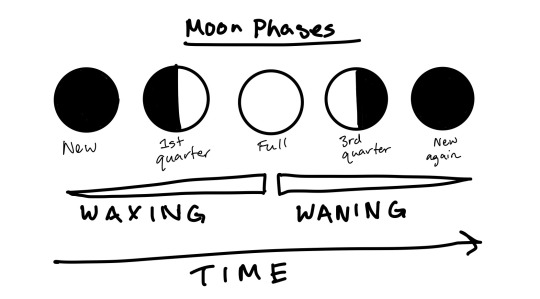
The fun trick I was taught to remember which way the cycle goes is “light from the right.” (Southern hemisphere people, you’ll have to flip this one.) Light, or shadow, moves from the right edge of the moon to the left. So if the moon is a crescent and the right edge is lit up, it’s waxing, or moving towards full. If the moon is a gibbous with a dark right edge, it’s just past full and will be waning towards the third quarter over the next few days. If you look at the diagram above (and imagine the crescent and gibbous phases transitioning in between), this might be easier to imagine.
Like I said, for the southern hemisphere this would actually be “light from the left.” If you’re near the equator and the moon is overhead, you could use “light from the west,” because that’s secretly the real rule. Another thing that’s useful to know for stargazing—the moon, sun and planets follow a path in the sky called the ecliptic, which is roughly over the equator. (Not exactly—it wiggles around relative to earth’s surface, because of the tilt of the earth’s axis that causes the seasons, but it stays near the equator.) If you’re standing in the northern hemisphere, the equator is south of you, so the ecliptic is also in the southern part of the sky. When you look at the moon, it will always be in the south, so the west-facing side of the moon will always be to your right. Likewise, if you’re in the southern hemisphere, the moon (and sun, and planets) will always appear in the northern half of the sky, so west will be to your left. Light moves across the moon’s surface from the west to the east.
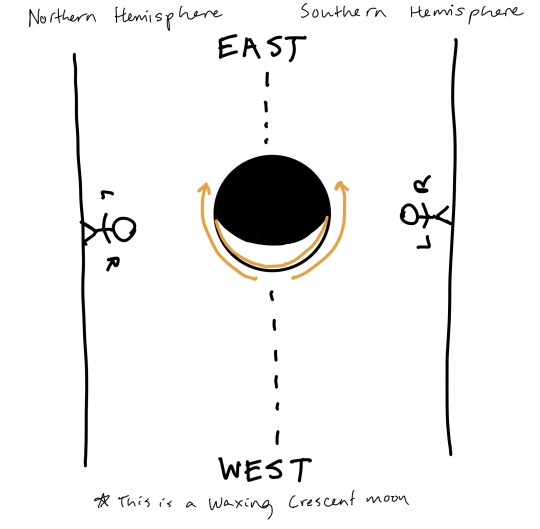
Now you can impress people by looking at the moon and saying, “Oh look, what a lovely waxing gibbous!” (I don’t actually know if the is impressive, but I do it all the time. For bonus points, get an app on your phone that tells you the phase of the moon and check it frequently so you can plan when to stargaze. Then you can casually mention that the moon will be full in a couple days when it’s not even in the sky, and maybe people will think you’re a werewolf.)
Now that I’ve explained the moon’s phases, I get to explain how they’re related to the time and place that the moon is in the sky. See, most people (I assume) don’t think twice about things like, say, a book describing a crescent moon in the sky overhead at midnight. But that actually can’t happen! And it has to do with the moon’s position in the 3D solar system, and how that maps onto our sky. This is kind of hard for me to explain without a lot of 3D hand gestures and pointing at the sky, but I’m gonna do my best to show it in two dimensions.
So, most people probably know that the moon’s phases are caused by the sun’s light illuminating half of the moon, and since the relative positions of the moon, sun & earth change throughout the month, the half that’s illuminated moves around the moon and changes how it looks from our viewpoint. So, a very basic rule: the side of the moon that’s illuminated is the side that’s facing the sun.
So, when the moon is full, that’s because the side that faces us is also facing the sun. This means the sun is directly opposite the moon. Here’s a very scientific diagram:
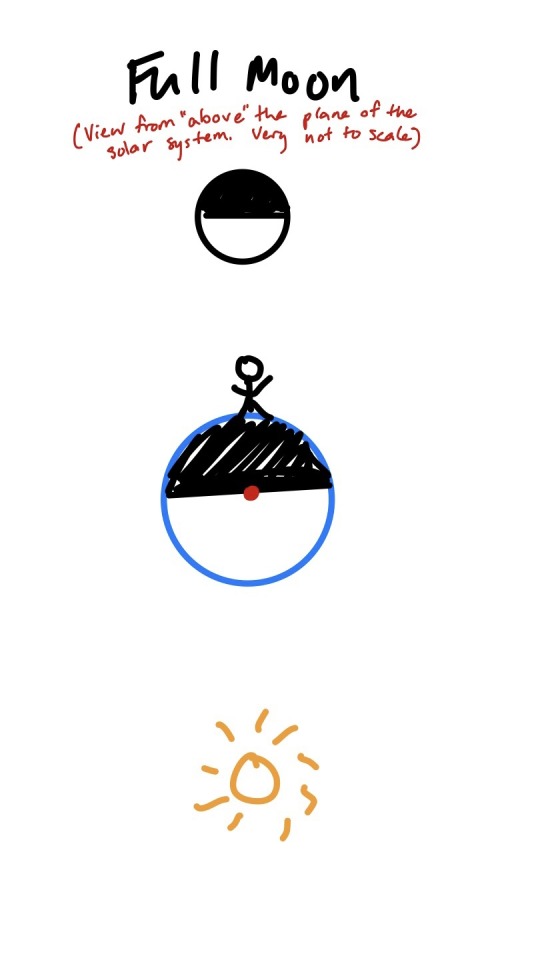
In case it’s not clear, this is a “top-down” view of the solar system where the moon, earth and sun are all in the same plane (in this case it doesn’t matter if we’re looking at the north or south pole, the positions would look the same). It’s also obviously not to scale and very simplified, but the point is to demonstrate that the moon is opposite the earth from the sun.*
The little person on the earth is of course spinning around as the earth rotates once per day. But at this point in the lunar month, you can see that when they are on the side of the earth where they can see the moon, they are also on the side facing away from the sun. When the moon is full or close to full, it’s opposite the sun—it rises around sunset, sets around sunrise, and is at its peak in the sky around midnight. This is how lots of people tend to think of the moon rising and setting, but it’s only true when the moon is close to full!
If that doesn’t make sense, here’s a diagram of when the moon is at the opposite point in its cycle, a new moon:
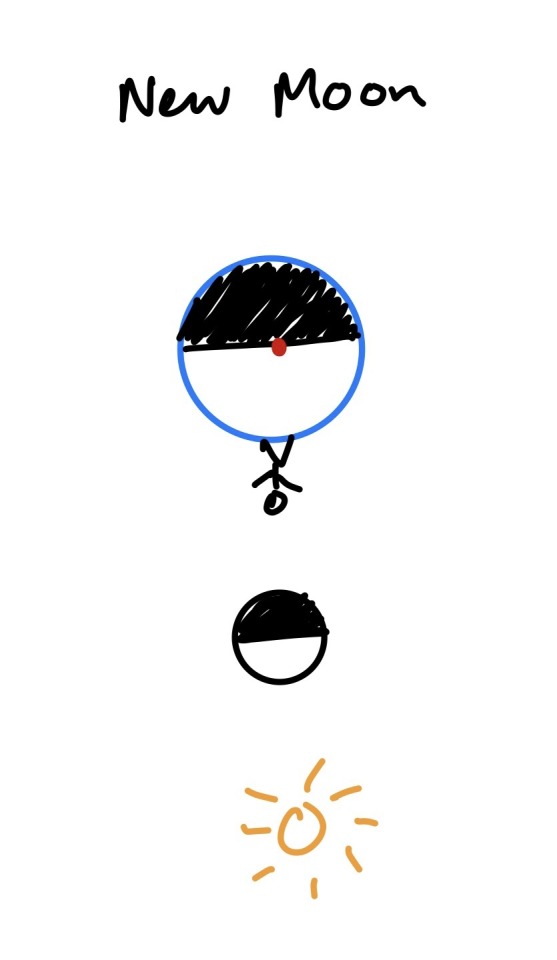
When the moon is new, the side that faces the earth is dark, which means the opposite side is facing the sun. The moon is on the same side of earth as the sun is. The little person spinning around the earth won’t see the moon in the night sky, because the moon is close to the sun in the sky,* and it’s actually rising in the morning and setting in the evening at this time of the month! You can’t easily see the moon when it’s new, but it might be visible a few days before or after this as a crescent. You’ll only see a crescent moon in the sky during the day, or close to dawn/dusk—it will be close above the horizon where the sun has just set or is about to rise. (The light edge faces the sun, so if it’s near the horizon in twilight sometimes it will look like the light edge is actually pointing down, with the tips of the crescent pointing up in the sky.)
*A side note on eclipses: My diagram is oversimplified! The moon, earth and sun aren’t actually all in the same plane all the time, they’re slightly misaligned. So even when I say the moon and sun are “directly” opposite each other, or aligned, they aren’t lined up perfectly enough to cast shadows on each other most of the time. When they do line up perfectly at the right time, that’s when you get a solar eclipse (when the moon is new) or lunar eclipse (when the moon is full).
Okay, so when the moon is full it’s in the sky at night, and when the moon is new it’s in the sky during the day. What about in between? This is where it gets a little confusing, especially for those of you in the southern hemisphere, who are going to have to flip everything I say. Apologies in advance, but it kind of hurts my head even to explain how this works in my own half of the sky.
So, when the moon is half-full, at the first quarter and third quarter of the phase cycle I explained above, the sun’s light is coming (from our perspective) from the side. The moon is ninety degrees away in its orbit from full or new, and the sun’s light is effectively perpendicular to our viewpoint, instead of parallel. This time it matters which way we’re looking, so these are a top-down view from the northern-hemisphere side. If you’re in the southern hemisphere, I think you can flip which is the first & third quarter to make this accurate.
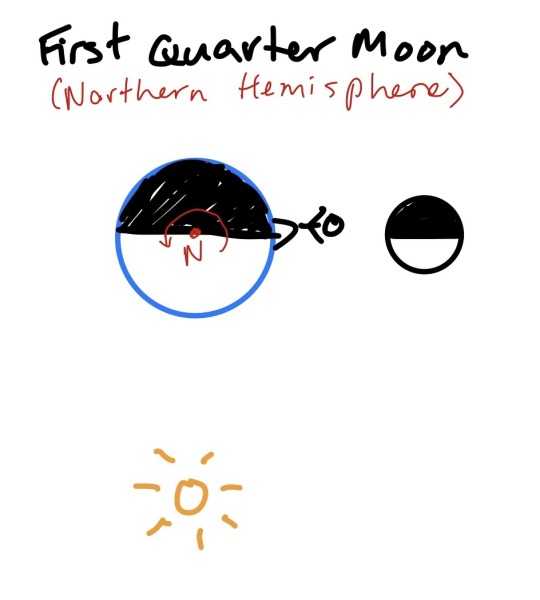
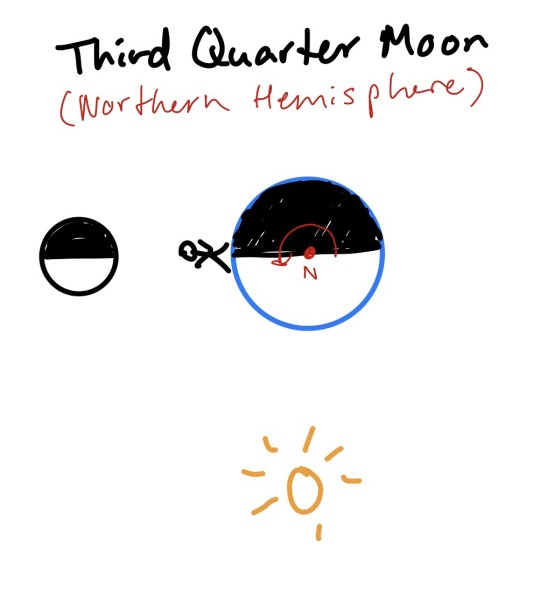
As you can see, when our little person is spinning around the globe, they’re going to be seeing the moon high in the sky right around the line between night and day. From a northern perspective, the earth spins counter-clockwise (vice versa from the south), so if you picture the person spinning around their little earth, you can see that the first quarter moon is going to be visible when they’re spinning from light to dark (sunset) and the third quarter moon is going to be visible when they’re spinning from dark to light (sunrise).
Bonus fun trick: If you remember the rule of “light from the right” in the northern hemisphere and how that determines the order of the phases, and look at these diagrams again, you can figure out which direction the moon orbits the earth from this viewpoint. (This is, in fact, the only way I can remember which direction the moon orbits the earth, despite being far more complicated than just memorizing it. If you’d like to make a game of it, I’ll put the answer at the bottom of the post).
Remembering how this looks from this top-down floating-above-the-earth perspective is hard, but you don’t really have to. I only explained it so it would make sense when I went back to my earlier visualization, from when I was explaining how “light from the right” works. I’m a very spatial learner, and I like picturing things relative to my own body, so this is how I remember when the different phases of the moon appear in the sky:
Imagine you’re standing, facing the ecliptic, where the sun and the moon travel through the sky. In the northern hemisphere, you’re facing south, with east to your left and west to your right. Imagine that the sun has just set, falling beneath the horizon to your right. Imagine that the moon is full, and hopefully I’ve explained well enough that now you know where it will be—cresting the horizon at your left. Imagine the opposite too—the sun is rising in the east at your left, as the full moon sinks in the west at your right. The new moon’s position, if you’d like to visualize that, is effectively the same as the sun.
Now, the difference between the two half-moons. Light comes from the west—in the northern hemisphere, your right—so when the right half is illuminated, it’s the first quarter of the lunar month, waxing to full, and when the left half is illuminated, it’s the third quarter, waning to new. One is high at dusk and one is high at dawn. Which is which?
You’re facing south. Picture a first quarter moon, right side lit up, at its peak in the southern sky. The light side is always facing the sun. Where is the sun? It must be to your right, touching the horizon in the west, setting. The first quarter moon is in the sky before, during and after dusk.
Picture a third quarter moon, left side lit up, at its peak. The light side faces the sun. The sun is to your left, touching the horizon in the east, rising. The third quarter moon is in the sky before, during and after dawn.
When I imagine this, I’m standing on my back porch, where I often go outside and stargaze. My telescope is small and one of the few things it can see with any detail is the moon. I want to be able to look at the moon just after dark, without having to stay up too late—and this memory device, of facing south and imagining the sun at my right hand to the west, is how I remember that the first quarter is the best time for me to observe the moon. It will be high in the sky at sunset, easy for me to see over the houses and trees.
If you remember that the moon waxes and wanes from the west (right in the north, left in the south), then you can fill in all the gradations of crescent and gibbous moon between the four main quarters. (As an example, if I wait a few days past first quarter to go outside and look at the moon, it’s waxed into a gibbous moon and it rises later in the evening, peaking in the sky closer to midnight. Another example: a waxing crescent is between a new moon and first quarter, so it will trail behind the sun and be above the horizon in the southwest at sunset.)
I hope that all of this makes sense and is useful to someone, whether for figuring out when you can observe the moon and where in the sky to look, or for thinking about how to place it in the sky in your writing and art. If nothing else, I hope I have brought you entertainment, and/or ruined the way the moon works in Minecraft for you forever. (It rises and sets directly opposite the sun!! Even when it’s a new moon!!! Light doesn’t work like that!!)
And finally, if you were trying to guess, the moon orbits the earth counter-clockwise if you’re looking down from the northern side.

#stars has thoughts#space#the moon#amateur astronomy#thank you for coming to my ted talk#and thanks discord friends for saying 'write the moon infodump post!!'#when i was like 'i wonder if i should write a moon infodump post'#i am a humble space nerd slash backyard astronomer with a 4inch scope#but explaining how i visualize and remember space stuff in simple terms is one of my favorite things to do ever#i could do a bunch of other posts about stuff like this. why venus is the morning star. how telescopes work (explain it like i'm 5 edition)#perhaps i will#undescribed#(i will try to come back with image descriptions later but i have already done all the explaining of visual concepts with words#that i can manage today. apologies)
71 notes
·
View notes
Text

The Omega Nebula (M17) in Sagittarius - July 2024
Photo by Turricula 556x10" exposure (93 min) Stacked and stretched in Siril Color balancing, noise reduction in Photoshop
#seestar#seestar s50#astronomy#astrophotography#space#deep space#nebula#siril#milky way#backyard astronomy#budget astronomy#driveway astronomy#planetary nebula#messier 17#swan nebula#omega nebula#sagittarius
29 notes
·
View notes
Link
Welcome to Astronomy Daily, your ultimate source for the latest in space and Astronomy news. I'm your host, Anna, and today we have an exciting lineup of stories that will take you on a journey through some of the most intriguing recent updates in the cosmos. Whether you're a seasoned space enthusiast or just curious about what's happening up there, this podcast is the perfect place for you to catch up on the latest discoveries. So sit back, relax, and let's dive into today's stellar stories. - **Asteroid That Wiped Out the Dinosaurs Originated Beyond Jupiter**: Recent findings have shed new light on the asteroid that ended the reign of the dinosaurs. Researchers have pinpointed that this massive asteroid, which collided with the Yucatan peninsula 66 million years ago, originated beyond Jupiter. - **China's Tianwen-1 Mission Unveils High-Resolution Global Color Map of Mars**: China's Tianwen-1 mission has released a groundbreaking, high-resolution global color map of Mars. This map offers unprecedented detail and accuracy, surpassing previous global images with a resolution of 76 meters per pixel. - **Hypervelocity Star Discovered by Citizen Scientists**: A hypervelocity star named J1249+36 has been identified by citizen scientists participating in the Backyard Worlds: Planet 9 project. This star is speeding through our galaxy at about 1.3 million mph, making it the first very low mass hypervelocity star discovered. - **Ensuring Astronauts' Mental Well-Being in Space**: Life on the International Space Station (ISS) can seriously impact the performance and well-being of astronauts. Studies on the ISS are focused on understanding these effects and testing new technologies to counteract them. For more Astronomy Daily, including our continually updating newsfeed, visit our website at astronomydaily.io. Follow us on social media at AstroDailyPod on Facebook, X, YouTubeMusic, and TikTok. We love engaging with our community, so be sure to drop us a message or comment on your favorite platform. For more Space and Astronomy News Podcasts, visit our HQ at www.bitesz.com. Become a supporter of this podcast: https://www.spreaker.com/podcast/astronomy-daily-the-podcast--5648921/support. Keep looking up, and I'll see you next time!
#asteroid#astronomy#backyard#citizen#dinosaur#exploration#extinction#global#hypervelocity#impact#map#mars#mission#news#project#science#space#star#tianwen-1#worlds
2 notes
·
View notes
Text

I spent most of the night capturing OIII (Oxygen 3) and SII (Sulfur 2) data in the IC1396 region in Cepheus, enough to combine with last week's Ha (Hydrogen-alpha) data to create a SHO color image, mapping sulfur to red, hydrogen to green, and oxygen to blue in RGB. I've balanced the RGB intensity, but left green for Ha a bit higher. Hydrogen is the most abundant element in the universe—by a very wide margin, and without balancing the Ha, OIII, SII channel values, most nebulae would be overwhelmingly green. That said, I do like to keep more hydrogen green in my images, making them a bit truer to the emission values of most deep sky objects.
36 notes
·
View notes
Text

Another picture of the last full moon 🌝 🌕 ❤️
5 notes
·
View notes
Text

KeepLookingUp -
Barnard #Astronomical Society will be holding their next #StarParty at Cloudland Canyon disc golf parking area this Saturday, July 5 from 8-11 PM., an evening of astronomical observations with visual telescopes, Electronically-Assisted scopes and monitors, and just looking up with our eyes!
Family-friendly, accessible, and guaranteed awesome!
Note: BAS events are free to all, but Cloudland Canyon requires a $5.00 parking fee per vehicle.
#Keep Looking Up#Science Rules#Backyard Astronomy#Chattanooga Astronomy#To The Sky#Astronomical Observation#Amateur Astronomy#Encouraging Astronomy#Barnard Astronomical Society
0 notes